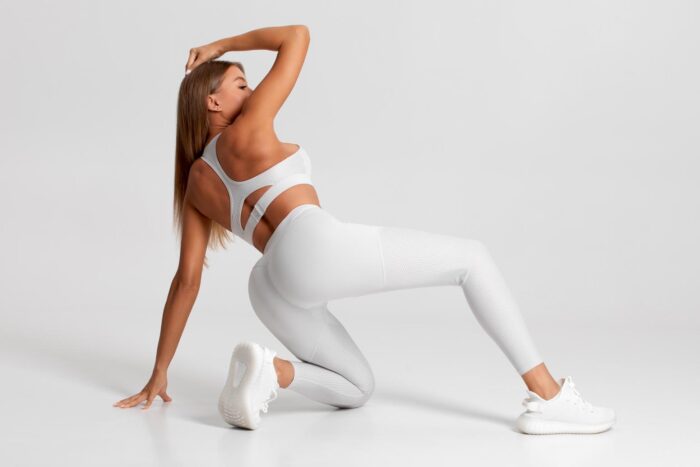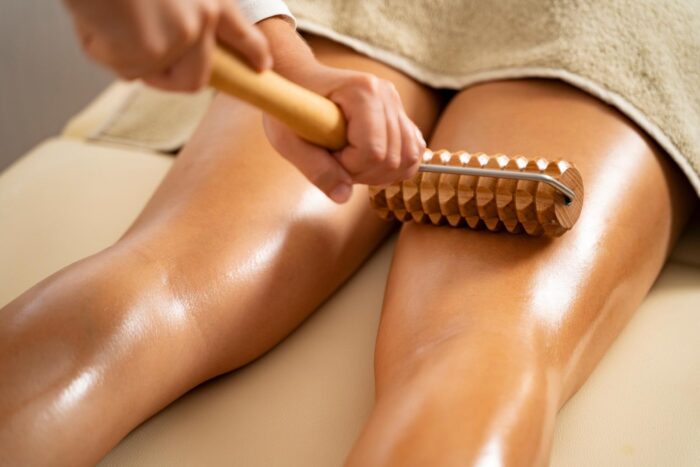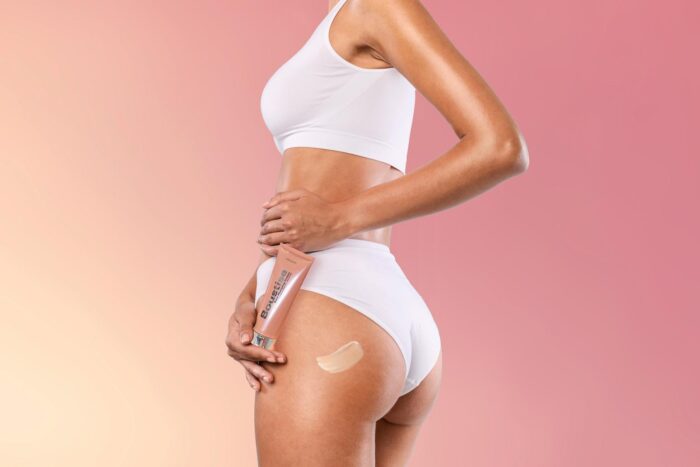
Toned and hydrated skin is something most of us would like to maintain. After experiencing weight loss, pregnancy, or just simply through the process of getting older, the once vibrant, taut skin we took for granted in our youth may change.
It can become slackened, thin, and sag, with the possibility of excess loose skin in more dramatic cases of rapid size reduction.
These body issues can affect some more than others due to inherited skin genetics and repair ability.
Repair capacity is influenced by stored cellular nutrition and impaired by prolonged stress and modern toxin exposure.
Increasingly, scientists have been focusing on the maintenance and enhancement of collagen and elastin production, in the deep and superficial tissues.
These are key factors in maintaining the look of youthful, plush, firm skin.
Can I Tighten Loose Skin with Exercise?
When it comes to tightening skin with exercise, there is a variance in what you can expect, depending on the areas of the body you want to target. If you have loose skin on your arms, butt, and legs, this method is more likely to show results.
By working out, you are supporting and reducing the look of loose and sagging skin with newly developed underlying muscles accompanied by healthier circulation. If you are trying to lose weight, you need to balance your exercises.
Focusing on excessive calorie-burning cardio exercises can lead to loose skin by increasing cortisol-induced stress levels and adding excess inflammation with incomplete repair time.
This affects innate hormone levels and can exacerbate the look of thinned, dehydrated skin. The best would be a mix of strength training and cardio-based exercise for balanced hormones and immune and circulatory benefits.
Also, strength training helps add supportive volume under the skin, so it shows less laxity after dramatic fat loss.
It is important to have a balance of aerobic and resistance training exercises. That way, you keep your curves as you lose weight.
If you have already lost weight and are experiencing saggy skin, you should step up your strength and resistance training.
Exercising works well for arms, legs, and the butt. It works less well for the stomach area and waist alone. By adding massage, and/or oils, and treatment creams to these areas, the combination can be more effective.

Can Massage Tighten Loose Skin?
Massaging loose skin is a technique you can try at home using body tools by yourself, with a willing partner or trained therapist. As massage benefits muscles, it also helps improve the condition of your skin by enhancing the vital flow of nutrient-rich blood to target areas of atrophy. This helps to strengthen weakened structures and thinned skin.
Aromatherapy essential oil massage is one of the best treatments to try when you are combating sagging skin. Essential oils such as geranium, frankincense, lavender, or rosemary, infused in a carrier such as almond, jojoba, or grapeseed oil, can help to boost skin quality. These oils are all noted for various skin healing benefits, such as increased microcirculation and collagen and elastin production in the skin.
There are various massaging tools and combinations of techniques you can try at home. It is good to experiment and see which ones work the best for you.
Can Infrared or Light Therapy Help to Tighten Loose Skin?
Infrared and red light therapy have been around for decades in spas to enhance skin treatments and boost circulation. Only recently, with a bevy of new studies completed in the past few years, have their benefits and effectiveness come into focus within the mainstream beauty industry.
Both red light and infrared therapy have proven to positively contribute in improving skin appearance. To better understand how this works, it helps if we can understand how they can affect the various skin layers.
The skin is the body’s largest organ, made up of three layers. The top layer is called the epidermis, the middle layer the dermis, and the bottom layer is called the hypodermis, which can extend to a depth of 3cm in areas of the body like the abdomen and hips.
Red Light (RL) 630-660 and Near-Infrared (NIR) 810-850 are the 2 most commonly combined visible wavelengths, with various studies proving their efficacy in the skin. RL has a positive effect from 5mm depth, affecting the superficial epidermal skin texture. NIR penetrates just over 2 inches depth in the body, where it can affect and regenerate deeper supportive tissue structures.
Invisible Infrared light affects the layers within the hypodermis which ultimately helps to tighten the deep structures as it extends closer to the muscles where there is a higher supply of oxygen.
Can Cold Showers and Cryotherapy Tighten Loose Skin?
If you have a small amount of loose skin and are looking for more skin firming, this may help. The results may be more temporary when used alone and not combined with other treatments.
Cryotherapy and cold showers are good options for mild firming effects through the mobilization of lymph and reduction of accumulated fluids. A more effective option is to combine hot and cold therapy for those needing more help with loose skin issues.
Many Scandinavian women believe using saunas with cold therapy regularly helps them maintain firm and youthful skin even into older age. When you do traditional sauna therapy, you use both hot and cold treatments by alternating to an ice lake or cold ice bath afterward.
The process of the blood vessels opening and then closing again quickly, acts almost as a pump to help flush toxins and invigorate the cardiovascular and immune systems. It is thought that sauna therapy helps enhance collagen production by allowing fresh nutrient-rich blood to circulate into the extremities with the dilation of the blood vessels.
With the extreme cold, blood rushes back into the core due to blood vessel constriction. It concentrates in the body’s center, driving fresh circulation into areas where stagnation and toxin buildup may have been occurring around the life-sustaining organs.
This process produces a reinvigoration of natural endorphins, enzyme and hormone production, resulting in fresh, glowing, collagen redensified skin.
Can Foods Help to Tighten Loose Skin?
This is where the fundamental science behind loose skin gets interesting. It appears that what we eat is the primary factor influencing the body’s ability to regain tightness and reduce the look of sagging skin.
Many foods are rich in compounds that help to boost internal collagen production. Depleted collagen and elastin lead to a more thinned, lax appearance of the skin. Rebuilding the body’s nutritional stores allows for previously incomplete repair and tightening of the skin to resume and increased hydration and thickness to return to the dermal layers.
Eating cold-water fish rich in Omega-3 essential fatty acids is vital for skin health. The healthy oils in cold water fish, help to reduce inflammation in the skin, making it more supple. Omega-3 oil also helps to protect the membrane surrounding cells. This supports the skin’s structure leading to fewer wrinkles and tighter skin.
Red vegetables and fruits contain a natural compound called lycopene. Tomatoes, red peppers, watermelons, and pink grapefruit are all great sources of this collagen-boosting compound which help with lax skin due to aging or sun damage.
Vitamin C-containing fruits and vegetables are also beneficial to combine with lycopene, as they work together, to enhance skin-firming effects.
Dark green vegetables are a fantastic source of vitamin A. One of the primary functions of vitamin A is to help the skin produce collagen and help with skin turnover.
Can Vitamins and Supplements Tighten Loose Skin?
You can use vitamins and supplements to help to tighten loose skin. As we previously mentioned, what we eat is essential to our skin’s overall health and appearance. Loss of biodiversity, topsoil degradation, and longer supply chains of essential produce items have become more common in the last 70 years. This has contributed to the gradual decline of key minerals and vitamins held in those foods.
A good multivitamin and trace mineral supplements can help fill in the nutritional gaps that contribute to incomplete dermal repair and lax sagging skin. Mineral supplements can be purchased contained in whole food powder form and as a capsule. You should boost the chances of your supplements working by adding probiotics, healthy oils, and Omega-3 to your daily routine.
It is important to take vitamins and supplements in the right way. Ideally, you should take them within 30 minutes of meals when they are better utilized by the body when digesting food with a wide array of supportive micronutrients. Late morning and lunchtime are ideal for vitamins, as the liver flushes toxins in the early morning. In the evening, it shows enhanced absorption for certain minerals.
How Long Does It Take to Tighten Loose Skin After Weight Loss?
Factors that influence how fast and effectively your skin can tighten back are the state of your general health and age. If you have lost weight rapidly, you are much more likely to end up with loose skin, with more sagging, particularly on your stomach. If it is due to aging, inflammation, or elongated periods of stress, the sagging skin can show up in various parts of the face and body.
As we get older, collagen production slows down. This makes it harder for the skin to knit back together again. If your skin is damaged and is low in vital nutrients for tissue regeneration, it will also take longer for your skin to repair.
As previously mentioned, nutrition and exercise can largely influence the speed of your skin-tightening results. While it is important to do aerobic exercise for weight loss and burning calories, it is just as important to include strength training and toning to support the skin.
Adding topical nutrition to the skin can be very helpful to directly target trouble spots. This can come in the form of creams, oils, lotions, and serum concentrates and can be effective in helping to tighten areas that are difficult to reach with exercise alone.
A helpful tip is to ensure you are not using any body lotions containing toxic ingredients. They only add inflammation to the skin, worsening its underlying appearance under the sheen. It is also thought that parabens in skin lotions can slow down collagen production.
Specialized clean body products that help to tighten and reinvigorate curves with powerful nutrients and skin-repairing extracts have also recently become popular in the market. One example is the body beautification line, Boustise Breast and Bum Enhancement Creams.
They contain deep skin hydration and plumping actives, supportive structure repair and skin smoothing super-extracts for the modern answer to body contouring from a bottle.
Does Loose Skin Get Better On Its Own?
Skin can continue to improve, on its own, from one month to a year without any other lifestyle changes. By incorporating some or all of these various methods we have discussed, the level of natural improvement may be exactly what you are looking for.
If more drastic surgical interventions are required, then at least you have put yourself into an optimum healing state to continue further. If you have lost weight and ended up with loose skin, it is important that you provide your body with the adequate support it needs to tighten and repair itself.
Final Thoughts
Improving loose and sagging skin can be challenging. Many of those wanting to see immediate changes may opt for surgery, but achieving ideal results can be dependent on your age and ability to repair. As we have previously shown, there are several things you can do to improve your skin health and quality.
Adequate sleep, exercise hydration, and a clean diet is fundamental. Taking supplements and vitamins will add faster results, while therapeutic treatments can amplify and help in difficult or stubborn areas. Patience and consistency are the most important factors to keep in mind when it comes to tightening and toning loose, saggy skin and curves.















